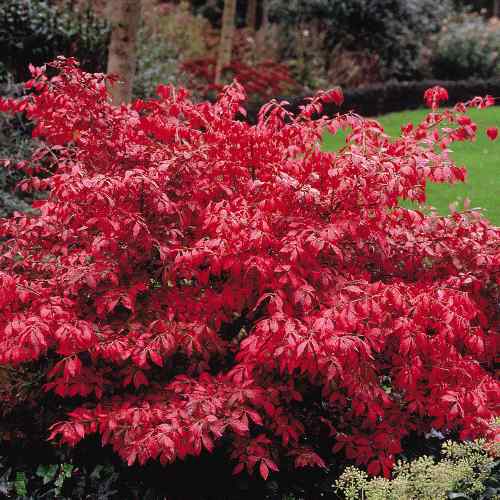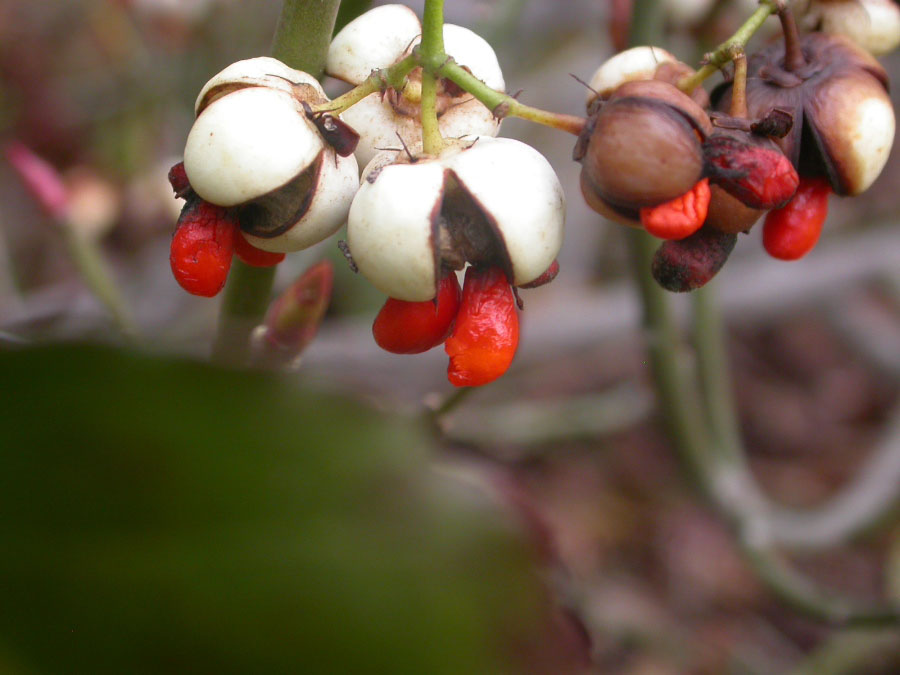Euonymus
This group consists of 170 evergreen and deciduous shrubs, small trees, creepers and climbers. Euonymus (Spindletree) are found wild throughout North and Central America, Europe, Asia, Africa, and Australia. These plants make great hedges, edging, and ground covers. The deciduous varieties are valued for their vividly colored fruits and gorgeous autumn colors. The evergreen types are valued for their handsome foliage, which is usually multicolored, as well as their tolerance to the salty sprays and winds of coastal regions. Spindle Trees produce their insignificant flowers in the spring or early summer. They are normally green or purplish and are followed, in mid-summer, by dazzling fruits, which open to reveal equally attractive seeds. Sometimes the fruit, seeds, and aril will all be contrasting colors. E. alatus (Winged Euonymus; Burning Bush) is a gorgeous, deciduous, medium-sized shrub that is one of the best for its autumn foliage, which turns bright crimson. The reddish-purple fruits open to reveal bright orange-colored seeds. E. fortunei var. Emerald 'n' Gold is an attractive, compact, dwarf shrub with dark green leaves edged with a wide band of brilliant gold. In the winter, this golden band turns creamy white stained with pink. If provided with support, this variety will climb. E. fortunei var. Silver Queen is another pretty, small-sized shrub, although it can reach a height of 8 to 10 feet against a wall. In the spring, the leaves unfurl with a pale yellow color, eventually turning green with a wide, white edge. Occasionally, this shrub will produce light green flowers that are followed by pink fruits. E. grandiflorus is a slow-growing semi-evergreen shrub that can grow up to 13 feet high. It produces large, yellow flowers and yellow fruits with scarlet seeds. The foliage turns wine-purple in the autumn. E. latifolius (Broadleaf Euonymus) is a deciduous plant that ranges in height from 11 to 16 feet. It has large, scarlet fruits and vivid autumn foliage.
Pot Cultivation
Spindle trees can be grown in almost any soil. They are tolerant of dry, shallow, alkaline soil and dry, shady areas. However, even though they are tolerant of all this, the deciduous species put on the best autumn display in sun. These plants also grow well near paths and other busy areas where the soil is compacted. Pruning consists of simply cutting away any dead, diseased, or damaged branches. Any shoots on a variegated plant that have reverted to green should be removed immediately to prevent the entire plant from turning plain green. Euonymus are susceptible to a variety of pests such as spider mites and thrips, but particularly scale. There are several different types of scale that attack Euonymus, but the worst is Euonymus scale. This pest can severely stunt the growth of a plant and even kill it. The whitish male clusters are found on the leaves and new shoots, while the brownish female clusters are found on more mature wood. Scales can be fatal to varieties of E. fortunei, E. europaeus and E. hamiltonianus. (Look up Scale as well as Spider mites and Thrips in the Index of Pests and Diseases to find ways to control and/or prevent these nuisances.)
Propagation
Most of the deciduous kinds can be increased by sowing seeds in sandy soil in a cold frame in the fall. They can also be increased by taking cuttings and layering branches outside in September or by detaching suckers. The evergreen kinds are increased by cuttings inserted in a propagating case in a greenhouse in late summer or early fall. Low-growing kinds can be increased by division in the spring as well as by cuttings.
 |
 |
| E. alatus |
E. fortunei |
VARIETIES
- E. alatus (Winged Euonymus; Burning Bush) & var. compactus;
- E. europaeus (European Spindletree) & var. albus, Red Cascade;
- E. fortunei (Winter Creeper) & var. Canadale Gold, Coloratus, Dart's Blanket, Emerald Gaiety, Emerald 'n' Gold, Gold Tip, Harlequin, Kewensis, Silver Pillar, Silver Queen, Sunspot, Variegatus;
- E. grandiflorus;
- E. hamiltonianus & var. Coral Charm, Coral Chief, sieboldianus;
- E. japonicus (Japanese Euonymus) & var. Duc d'Anjou, Latifolius Albomarginatus, Marieke, Microphyllus Aureus, Microphyllus Variegatus, Ovatus Aureus;
- E. latifolius (Broadleaf Euonymus);
- E. nanus & var. turkestanicus;
- E. oxyphyllus;
- E. phellomanus;
- E. planipes;
- E. americanus (Strawberry Bush);
- E. atropurpureus (Wahoo).






